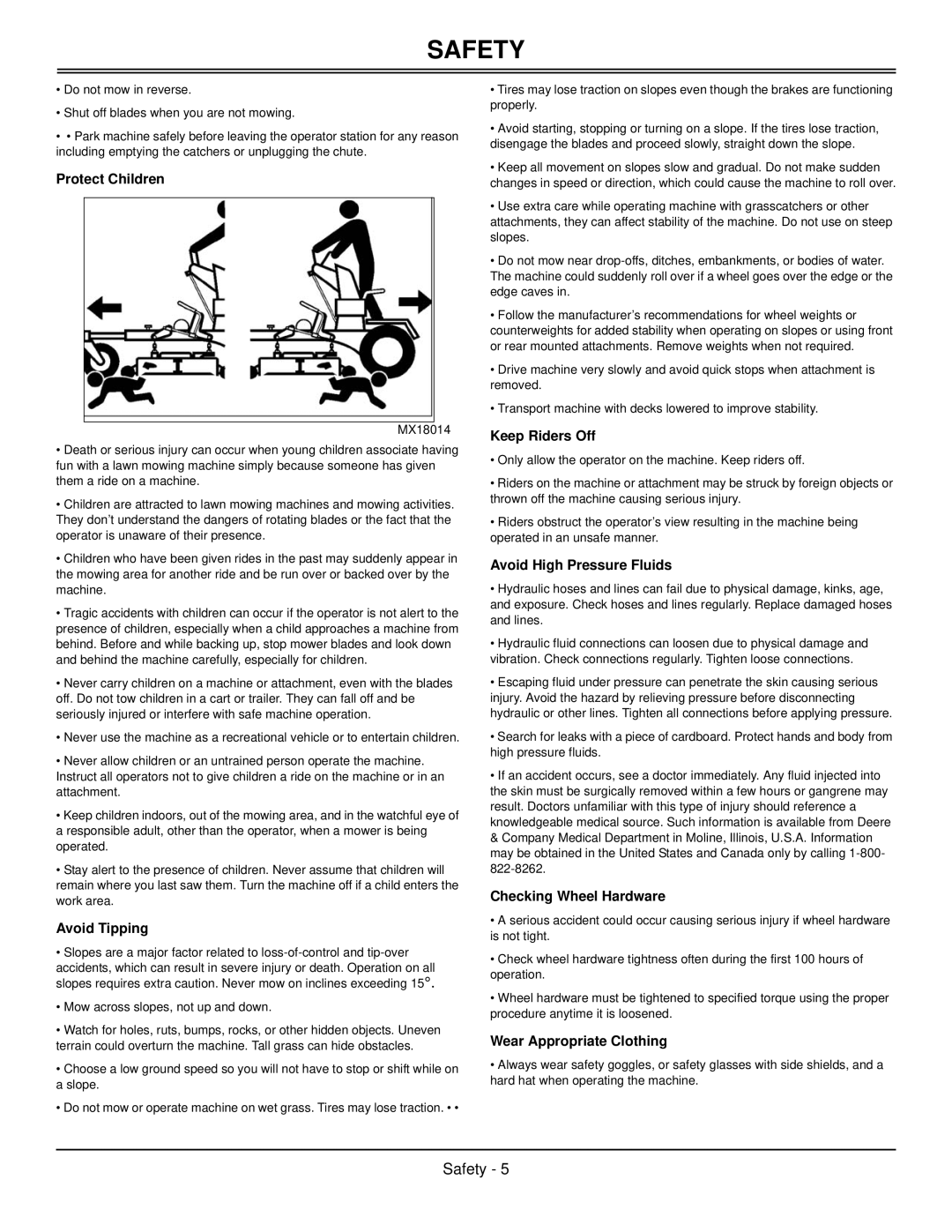•Do not mow in reverse.
•Shut off blades when you are not mowing.
•• Park machine safely before leaving the operator station for any reason including emptying the catchers or unplugging the chute.
Protect Children
MX18014
•Death or serious injury can occur when young children associate having fun with a lawn mowing machine simply because someone has given them a ride on a machine.
•Children are attracted to lawn mowing machines and mowing activities. They don’t understand the dangers of rotating blades or the fact that the operator is unaware of their presence.
•Children who have been given rides in the past may suddenly appear in the mowing area for another ride and be run over or backed over by the machine.
•Tragic accidents with children can occur if the operator is not alert to the presence of children, especially when a child approaches a machine from behind. Before and while backing up, stop mower blades and look down and behind the machine carefully, especially for children.
•Never carry children on a machine or attachment, even with the blades off. Do not tow children in a cart or trailer. They can fall off and be seriously injured or interfere with safe machine operation.
•Never use the machine as a recreational vehicle or to entertain children.
•Never allow children or an untrained person operate the machine. Instruct all operators not to give children a ride on the machine or in an attachment.
•Keep children indoors, out of the mowing area, and in the watchful eye of a responsible adult, other than the operator, when a mower is being operated.
•Stay alert to the presence of children. Never assume that children will remain where you last saw them. Turn the machine off if a child enters the work area.
Avoid Tipping
•Slopes are a major factor related to loss-of-control and tip-over
accidents, which can result in severe injury or death. Operation on all slopes requires extra caution. Never mow on inclines exceeding 15°.
•Mow across slopes, not up and down.
•Watch for holes, ruts, bumps, rocks, or other hidden objects. Uneven terrain could overturn the machine. Tall grass can hide obstacles.
•Choose a low ground speed so you will not have to stop or shift while on a slope.
•Do not mow or operate machine on wet grass. Tires may lose traction. • •
•Tires may lose traction on slopes even though the brakes are functioning properly.
•Avoid starting, stopping or turning on a slope. If the tires lose traction, disengage the blades and proceed slowly, straight down the slope.
•Keep all movement on slopes slow and gradual. Do not make sudden changes in speed or direction, which could cause the machine to roll over.
•Use extra care while operating machine with grasscatchers or other attachments, they can affect stability of the machine. Do not use on steep slopes.
•Do not mow near drop-offs, ditches, embankments, or bodies of water. The machine could suddenly roll over if a wheel goes over the edge or the edge caves in.
•Follow the manufacturer’s recommendations for wheel weights or counterweights for added stability when operating on slopes or using front or rear mounted attachments. Remove weights when not required.
•Drive machine very slowly and avoid quick stops when attachment is removed.
•Transport machine with decks lowered to improve stability.
Keep Riders Off
•Only allow the operator on the machine. Keep riders off.
•Riders on the machine or attachment may be struck by foreign objects or thrown off the machine causing serious injury.
•Riders obstruct the operator’s view resulting in the machine being operated in an unsafe manner.
Avoid High Pressure Fluids
•Hydraulic hoses and lines can fail due to physical damage, kinks, age, and exposure. Check hoses and lines regularly. Replace damaged hoses and lines.
•Hydraulic fluid connections can loosen due to physical damage and vibration. Check connections regularly. Tighten loose connections.
•Escaping fluid under pressure can penetrate the skin causing serious injury. Avoid the hazard by relieving pressure before disconnecting hydraulic or other lines. Tighten all connections before applying pressure.
•Search for leaks with a piece of cardboard. Protect hands and body from high pressure fluids.
•If an accident occurs, see a doctor immediately. Any fluid injected into the skin must be surgically removed within a few hours or gangrene may result. Doctors unfamiliar with this type of injury should reference a knowledgeable medical source. Such information is available from Deere & Company Medical Department in Moline, Illinois, U.S.A. Information may be obtained in the United States and Canada only by calling 1-800- 822-8262.
Checking Wheel Hardware
•A serious accident could occur causing serious injury if wheel hardware is not tight.
•Check wheel hardware tightness often during the first 100 hours of operation.
•Wheel hardware must be tightened to specified torque using the proper procedure anytime it is loosened.
Wear Appropriate Clothing
•Always wear safety goggles, or safety glasses with side shields, and a hard hat when operating the machine.

